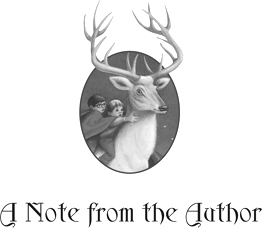Many people believe that the legend of King Arthur was inspired by an actual military leader who led Britain over 1,500 years ago.
Imaginary stories about the adventures of King Arthur were first told in Wales and Ireland. These stories are called Celtic myths. Sadly, most Celtic myths are lost to us forever because only a few were written down. Many details in my story about King Arthur’s realm are drawn from details in the few Celtic stories that have survived through the ages.
The cloak that makes one invisible was considered to be one of “the Thirteen Treasures of Britain.” Merlin the magician was said to keep the treasures in a glass tower. None of the magic of the treasures would work for a person who was unworthy to use them.
The white stag was inspired by a supernatural Celtic beast that often led humans to a hidden Otherworld.
The idea for the Cauldron of Memory and Imagination came from a 6th-century poem. The poem tells a story about King Arthur and his knights traveling to a hidden world and searching for a magical cauldron of poetry and inspiration. Many knights never returned from that dangerous quest.
In the 12th century, Queen Eleanor of Aquitaine encouraged poets and troubadours to make up more stories about King Arthur and the Knights of the Round Table to inspire her people. In the following years, storytellers all over Europe told heroic tales of King Arthur, Merlin, Sir Lancelot, Queen Guinevere, and Morgan le Fay. French poets were the first to call the imaginary kingdom Camelot.
The storytellers of the Middle Ages blended elements of Christianity with the old Celtic myths. In their stories, miracles and marvels often took place around Christian holidays. Christmas in Camelot was a time of joyous celebration.

